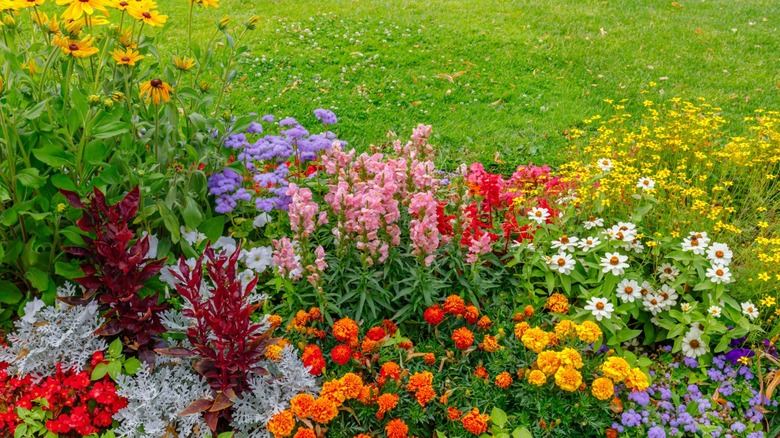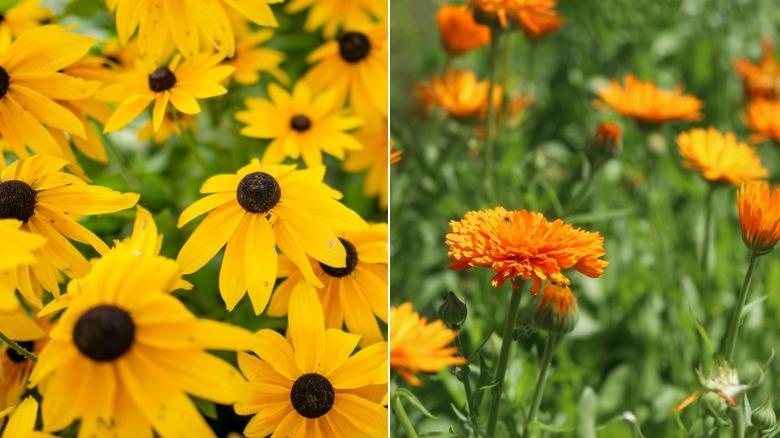Flowers You Should Plant In April For Showstopping Summer Blooms
Patience is often rewarded in the garden, whether you're waiting to harvest fresh tomatoes or planting flowers in anticipation of beautiful blooms. Planning ahead in early spring can mean an incredible flower show later in summer. A good portion of the U.S. has its last spring frost date in April, which makes it an important month for planting outdoors. It's a good time to start planting in your garden to have beautiful flowers that last into the summer.
If you want your flower beds to be full of showstopping blooms in the summer, begin growing coral bells (Heuchera), snapdragons (Antirrhinum majus), black-eyed Susans (Rudbeckia hirta), and calendula (Calendula officinalis) as soon as you can start planting in the ground. For some parts of the country, that might be earlier or later, depending on your USDA plant hardiness zone. But throughout April, temperatures become a little more moderate and the threat of terribly cold weather becomes more limited. By that time, you can start growing these plants together for a flower bed idea that will bring your outdoor space to life in the summer.
Add height to flower beds with coral bells and snapdragons
Showcase dimension in your summer garden by planting coral bells in April. Coral bells, also known as heuchera, are a genus of plants with many native to the U.S. that come in a variety of species displaying vibrant colors. With green, orange, yellow, and burgundy leaves and red, pink, or white flowers, coral bells provide interest with pollinator-friendly blooms. This plant can be grown as an evergreen or semi-evergreen groundcover and is hardy from zones 3 through 9. For coral bells species that will bloom into summer, select Heuchera sanguinea, Heuchera richardsonii, or Heuchera villosa. These species of coral bells bloom in late spring and early summer, except for H. villosa, which blooms in late summer and fall.
Another tall and interesting flower for your summer garden, snapdragons are commonly grown as annuals but highly tolerant of the cold and frost. With their unique appearance resembling a dragon's nose, snapdragons are an ideal choice for a gardener who desires beautiful colors in early summer. Colors range from pink to lavender to white to orange, with the flowers blooming on long stalks. A native to southwestern Europe and the Mediterranean, snapdragons are hardy from zones 7 through 10 without protection, and through zone 5 with protection. To grow and take care of snapdragon flowers, make sure to provide well-draining, rich soil and remove dead flowers to encourage continual blooming.
Start black-eyed Susan and calendula seeds outdoors
Enjoy colorful, cheerful blooms from black-eyed Susans in summer by putting seeds in the ground in April. Black-eyed Susans, otherwise known as gloriosa daisies, are a popular cut flower with their bright yellow or orange petals and domed center. This native, heat-tolerant flower may bloom anywhere from May to October, depending on your location. It is hardy from zones 3 through 8. Along with providing nectar for several important pollinator species, black-eyed Susans feed birds with seeds from spent flower heads. Plant them in well-drained soil in full sun for the best results. After their blooming is finished, black-eyed Susans are capable of self-seeding by dropping seeds which often return the next year if given the right conditions.
Calendula, also known as pot marigolds, can be planted by seed before the last frost date to ensure bright blooms by spring and summer. Deadheading older flowers helps extend the bloom time of this flower, which is native to the Mediterranean and hardy from zones 2 through 11. Popular as an herb, calendula is edible and is as comfortable in a vegetable garden as it is in a patio container. You can even plant this fast-growing flower with snapdragons for continuous colorful blooms, taking advantage of their similar growing conditions. Calendula is adaptable to a variety of soils as long as it is well-drained. The 3-to-6-inch flowers can be single or double, are often either yellow or orange, and resemble daisies.


